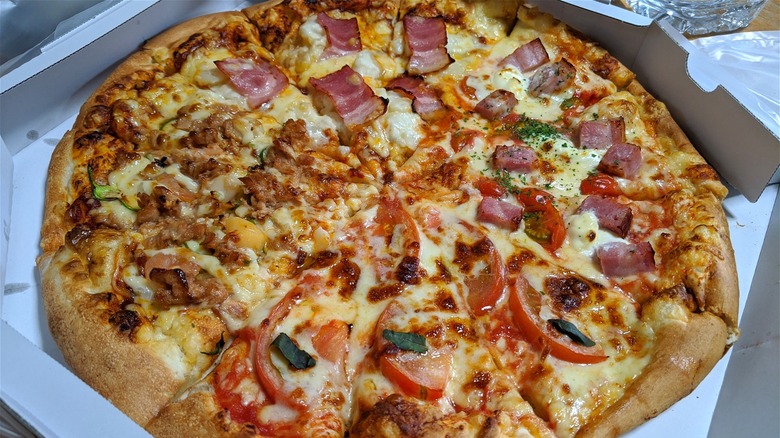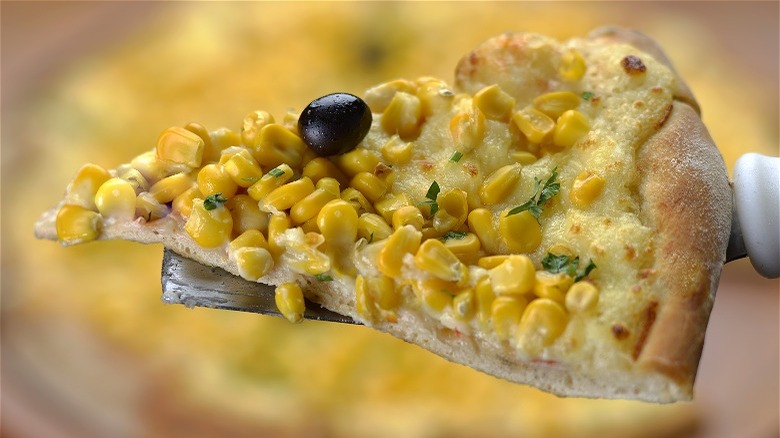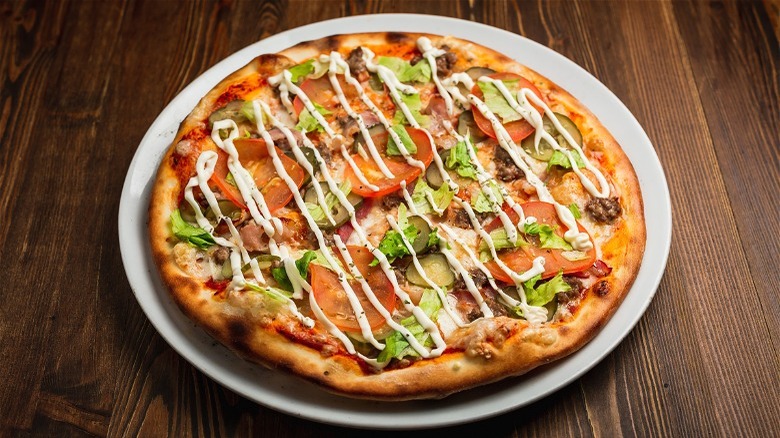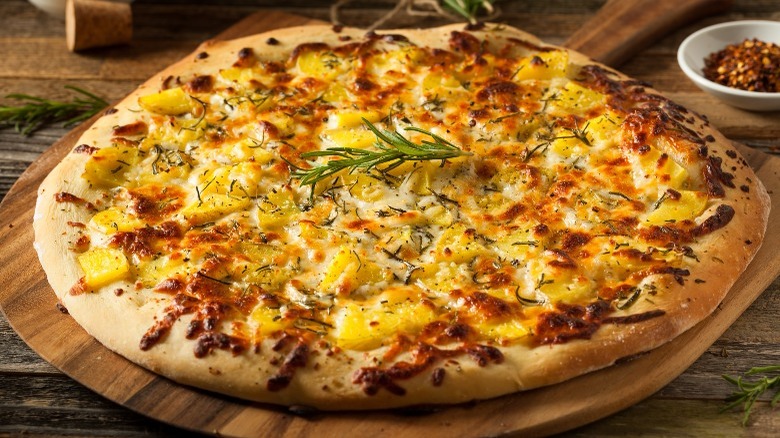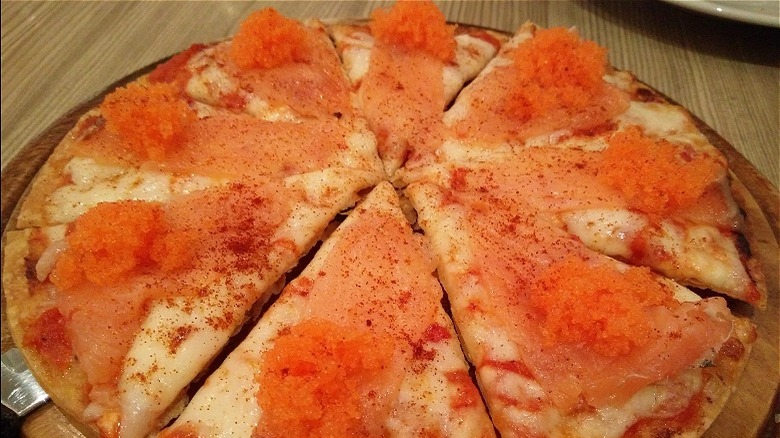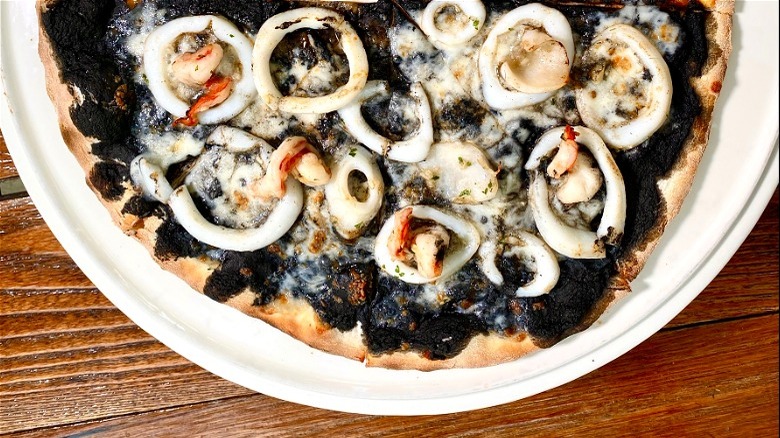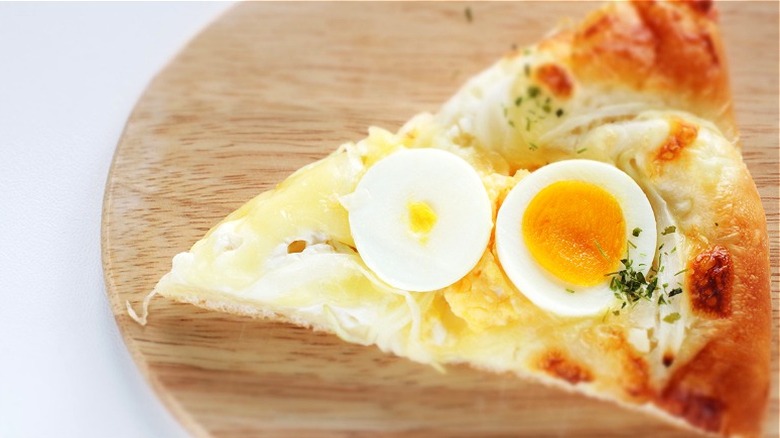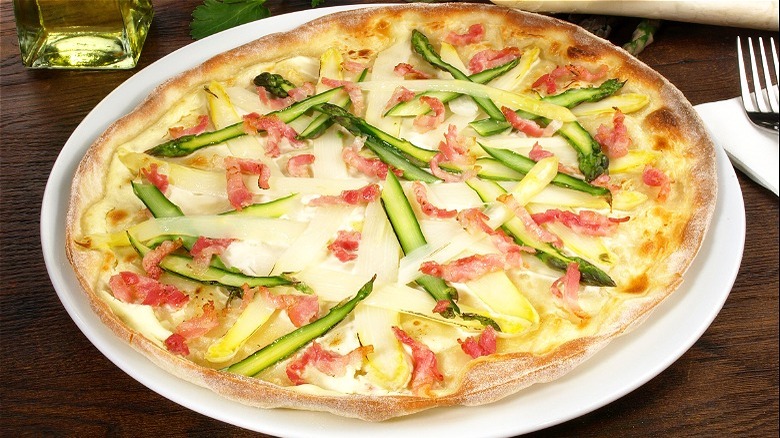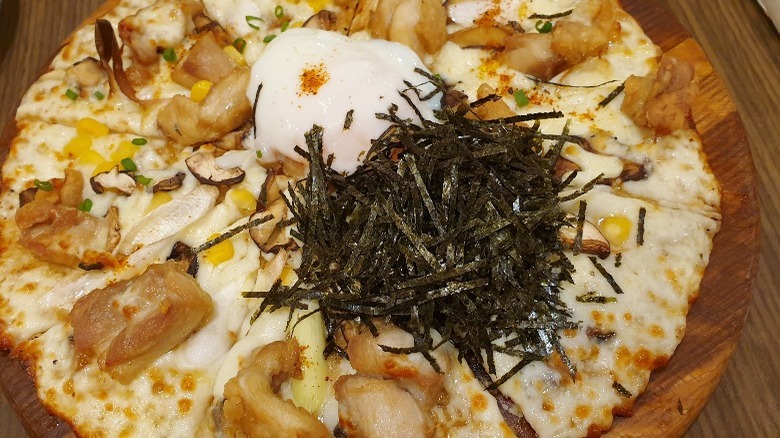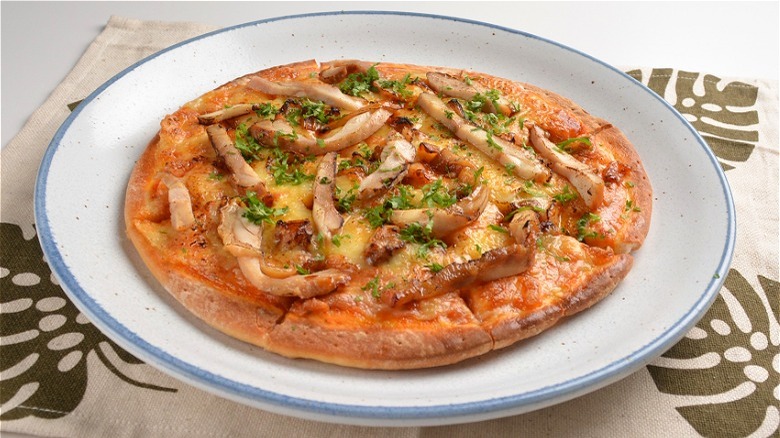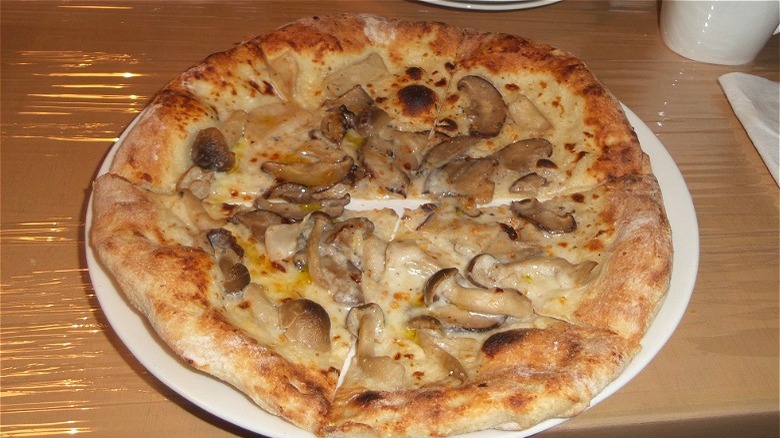The 10 One-Of-A-Kind Japanese Pizza Toppings You Shouldn't Miss Out On
Unlike ramen and sushi, pizza is not something we usually associate with Japanese food. But the pizza industry is alive and well in Japan. Major chains like Pizza Hut and Domino's even have a retail presence there. On top of that, there are local chains such as Pizza-La that remain active throughout the country, per Nihon Shock. The pizzas sold in Japan may not look as different as you'd expect, either. Japanese pizzas usually stick to the four basic components of American pies. They still come with a bread-like crust, tomato sauce, cheese, and toppings. However, it's this last part where Japanese pizzas set themselves apart from the ones that we're used to.
Japanese toppings provide an array of items you've likely never seen before. From seaweed to corn to mayonnaise, there are a whole bunch of foods that you would never expect to go with Italian foods such as pizza. Then, there are seemingly familiar toppings, like mushrooms or chicken, which are given a twist that makes them unlike the American pizzas you may have tried with similar ingredients. Baby Bella mushrooms are swapped for shiitakes and barbecue chicken is traded for teriyaki chicken. If trying unique foods intrigues you, read on. Here are the one-of-a-kind Japanese pizza toppings you shouldn't miss out on.
Corn
Vegetables are not an uncommon pizza topping category. Peppers, olives, and fresh tomatoes can be found on Little Caesar's menu. At more posh pizza restaurants, you might also encounter vegetables toppings like beets, squash, or brussels sprouts. But in Japan, one vegetable takes precedence above all the rest. That vegetable is corn.
According to multiple posters on this Reddit thread, corn is one of the most common and well-liked Japanese pizza toppings. It's often combined with other foods like potatoes, mayonnaise, and tuna. On Domino's Japanese website, there are multiple pies utilizing corn as a pizza topping. Corn is an ingredient in the company's Spicy Mayo and Mochi pizza, the Charcoal Grilled Chiki-Teri pizza, the Chef's Vegetable Special Pizza, and the Shrimp Mayonnaise Pizza. As SoraNews24 writes, corn is a quintessential Japanese pizza topping.
Japan's love affair with corn dates back hundreds of years, according to the Japan Times. Today, it is the world's biggest importer of corn, most of which the country gets from the United States. One popular way to eat corn in Japan is by dressing a cob with a marinade of soy sauce, mirin, and sugar (teriyaki sauce, essentially) and then putting the whole thing on the grill. Corn is also an ingredient often used for stir frys or soups. You might also come across it as a topping for ramen. This all goes to show that it may seem unique to us, but it's a normal pizza topping in Japan.
Mayo
It's not weird to want a little extra sauce with your pizza. Most of us have dipped a slice into some ranch. Others may reach for pizza dipping sauces like Papa John's garlic butter. But in Japan, mayonnaise is the add-on sauce of choice. Only there, it's applied as a pizza topping rather than a dipping sauce. Although this may sound off-putting at first, let's remember that mayonnaise is often a key ingredient in ranch dressing. That doesn't make it so different, does it?
When mayonnaise is used as a Japanese pizza topping, it usually involves a somewhat intricate design. The mayo is applied last, in thin strips that form a cross-hatch type of pattern, per Instructables. Sometimes, the addition of mayonnaise happens after baking, allowing the mayo to preserve its white color. Other times, it's applied before the pizza goes into the oven, meaning the mayo turns a yellow-golden color. This seems appetizing to us, as it then blends in with the cheese.
On Japanese pizzas, mayonnaise is usually found alongside other ingredients such as corn, potatoes, and meat. The combination of these four toppings creates a popular Japanese pizza called "Mayo Jaga," according to Brand Eating. Ordering a Mayo Jaga pizza in Japan is almost like ordering a pepperoni pizza in the United States. Most pizza businesses will probably have Mayo Jaga on their menu. At the very least, Domino's Japan offers one such pizza.
Potato
Although common in Japan, the country didn't invent putting potatoes on pizza. There is an old Roman recipe called "Pizza con Patate" which features potatoes as its main topping (via PMQ). It seems the Italians did it first. However, most iterations of Italian potato pizza are white pies, meaning they are made without tomato sauce. In Japan, potatoes are not exclusively served as toppings for white pizzas.
Per The Travel, the Japanese version of Pizza Hut has a potato pizza on its menu. The chain's unique Idaho Style Potato and Mayo Sausage Pizza is reportedly made with toppings of potatoes and sausage (as its name suggests). The meat and potatoes combination is also one appreciated by the Japanese chain Pizza-La. Its menu features a pie called Bulgogi Potatoes. Both the Pizza Hut and Pizza-La pies utilize a mayonnaise-based sauce, meaning it's somewhat of a white pizza. However, Domino's Japan makes its potato pizza with a combination of white (mayo-based) sauce and bolognese (a meat sauce that is usually made with tomatoes).
Potatoes being used as a pizza topping in Japan is not entirely surprising. There are a few common Japanese dishes made with potatoes. Some of these are potato salad or roasted Japanese sweet potatoes. We would gladly try a pizza with this particular Japanese topping. However, not everyone is a fan. On Facebook, one person said had mixed feelings about their Japanese pizza with this topping.
Seafood
Other than the ingredients of Mayo Jaga – corn, potatoes, and mayonnaise — seafood is one of the most popular topping categories in Japan. To be specific, you'll often find things like shrimp, crab, anchovies, lobster, salmon, or cod roe. According to one Reddit user, some Japanese restaurants may even put octopus on pizza.
Several pizzas sold by Domino's in Japan utilize these seafood toppings. The chain sells a pizza called the Seafood Special — which is made with shrimp — and another called the Local Harvest Quattro Autumn — which is made with salmon. On the menu of the Japanese pizza chain Pizza-La, you're more likely to find things like crab, anchovies, or lobster. Seafood is such as popular pizza topping that once, Domino's Japan took it too far. The chain added a fish and chips pizza to its menu. Some people didn't love it.
Japan is an island nation, meaning it's surrounded by water on all sides. It makes sense that fish has an important place in the culture, cuisine, and population. Outside of pizza toppings, seafood has a huge presence in Japanese cuisine. It's at the heart of nearly every sushi and sashimi dish, of course. But that's not all. Seafood is also used to make other popular Japanese recipes such as kaki fry (deep-fried oysters), takoyaki (octopus balls), or Ebi furai (fried shrimp).
Squid ink
Squid ink is another one-of-a-kind Japanese pizza topping. It's not the type of thing you might find at Japanese pizza chains like Domino's, Pizza Hut, or Pizza-La. However, some more high-end pizza restaurants in Japan may offer it. We know at least one Reddit user has sampled Japanese pizza with this topping because they wrote that they remembered ordering it. On top of this piece of evidence, we also discovered that a Japanese company once sold a frozen pizza topped with squid ink. According to Laughing Squid, the pizza was small enough to be made in a toaster oven.
This topping is unique both visually and in taste. The flavor of squid ink is similar to any other mild seafood topping you'll come across, however, it comes with an added satisfying umami-richness. The dark black color of squid ink is what makes it so tempting to taste. There aren't many naturally black foods.
Japan's fascination with black-colored foods has caught the attention of the internet once before. In the past, Burger King Japan sold a menu item of black hamburgers, in which the entire bun, cheese, and sauce were dyed black. Squid ink was used to dye the sauce. There are other Japanese food products using squid ink as well. If you visit an Asian grocery store, you may be able to find packages of prepared squid ink spaghetti.
Boiled eggs
If you're familiar with Japanese cuisine, you'll know that boiled eggs are used in many dishes. You'll often find them atop bowls of ramen. One Japanese preparation is called ajitsuke tamago. To make this type of boiled egg, each egg is boiled for a short amount of time, leaving the yolk most runny. Then, eggs are soaked in soy sauce, mirin (rice wine), and water. Another common boiled egg recipe in Japan is onsen tamago. This recipe requires slow-cooking an egg in hot water, which results in an extremely soft egg. Due to the popularity of these Japanese boiled egg recipes, it should come as no surprise that hard-boiled eggs are often used as a pizza topping.
According to one Reddit user, they regularly include hard-boiled eggs on pizza alongside other toppings like ham, corn, and tuna. On Tripadvisor, another person said they enjoyed eating a pizza topped with an onsen egg alongside mushrooms and squid. On Facebook, a person shared their take on Japanese pizza with hard-boiled eggs as a topping. Their picture appeared to depict a hard-boiled egg pizza with red sauce, some garnish, cheese, and potatoes. Due to the many positive reviews regarding eating a pizza with boiled eggs on top, we think trying this particular Japanese topping is bound to taste good.
Asparagus
Asparagus is another vegetable that you don't usually encounter on American pizza. But in Japan, getting a pizza with asparagus on top is not unusual. Per The Travel, Pizza Hut has a few different pies with asparagus on its Japanese menu. One of those is called the Koku-Uma Grill Pizza. It's made with toppings of bulgogi (beef or pork prepared in the style of Korean barbecue), bacon, and asparagus. Outside of Pizza Hut, you're likely to encounter other businesses that use asparagus as a pizza topping. One Facebook user said they had a pizza topped with asparagus, hot dog pieces, and mustard while in Japan. They appeared to enjoy eating it, despite the unique combination of toppings.
When used as a Japanese pizza topping, asparagus is usually prepared in short pieces that appear to be cut on a bias. Bias cutting is a common technique of preparing vegetables that results in longer, more asymmetrical pieces than rounds. You may have seen scallions, cucumbers, or carrots with a bias cut before. Per CookThink, some individuals think bias cutting improves the appearance of food. For asparagus pizza toppings, bias cutting results in small pieces of the veggie that can be confined to a particular slice. This helps you to be able to taste multiple toppings at once when eating a slice of pizza. It also ensures the asparagus won't fall off. This Japanese pizza topping sounds like a really good idea to us.
Kombu or nori
In Japan, you may find a pizza topped with ingredients like kombu or nori. Both are types of seaweed often used in Japanese cooking. When you taste a salty, briny flavor in your Japanese pizza, it is likely because of one of these two.
Nori or kombu may appear as toppings in the form of small, shredded bits. This can be seen in various depictions of Japanese pizza on Instagram and Facebook. People seem to enjoy it. One pizza lover on Facebook savored the combination of nori alongside chicken teriyaki and kewpie. If you are familiar with Japanese flavors such as seaweed, we recommend trying this topping.
Not only is kombu an iconic Japanese food, key to making dashi — a popular stock used for many Japanese soup recipes — its development is why we have the word "umami" today. The fifth flavor was discovered through research into seaweed and its high MSG content. With this discovery, umami joined the existing four flavors of salty, sweet, sour, and bitter. In addition to kombu, other umami-rich foods are tomatoes, onions, cheese, and mushrooms. Since many of those happen to be pizza ingredients, we can see how kombu would fit right in on a Japanese pizza.
Teriyaki chicken
Many Americans have tried teriyaki chicken before. That's because this dish first became popular in the U.S., not Japan. Per one origin story, the teriyaki chicken craze was brought on by Kikkoman, the soy sauce manufacturer. To try to increase sales, Kikkoman marketed teriyaki sauce — a combination of soy sauce, sugar, mirin, and sake — to Americans as a delicious new way to barbecue. Although certain aspects of the teriyaki tradition existed in Japan for centuries prior, it wasn't until the 20th century that the combination of teriyaki sauce and chicken was popularized in the West.
Possibly due to its current worldwide fame, you will find teriyaki chicken on many Japanese pizzas. This pairing of pizza and marinated chicken is similar to barbecue chicken pizza. Both glazes have an element of sweetness to them — although this sweet flavor is possibly stronger in teriyaki chicken. We find these marinated proteins work great with pizza, where the sweet-and-savory flavor mimics the pairing of sweet red sauce with savory cheese.
You will find teriyaki chicken toppings on the menus of Pizza Hut and Domino's Japan. According to The Travel, it is an ingredient in one Pizza Hut menu item called Grilled Teriyaki Mayo Chicken Pizza. Per Domino's, teriyaki chicken is a topping for several of its Japanese menu items, where it's called "Chiki-Teri." These pizzas include the Quattro Meat Max, the Quattro Giant, the Quattro Nippon, and the Charcoal-Grilled Chiki-Teri.
Mushrooms
Mushrooms may not seem like a pizza topping unique to Japan. This ingredient is something you've likely found on American pizzas. But the distinction between Japanese mushroom pizzas and American mushroom pizzas usually comes in the choice of vegetable.
Sometimes, those choices are driven by native crops, by selecting mushrooms that are indigenous to the country. Other times, it could be motivated by tradition. Some popular types of mushrooms used for American pizza toppings include portabellos or porcinis. In Japan, this isn't the case. Shiitakes, maitakes, oysters, and enokis are all common types of mushrooms in Japan. These are the varieties of fungi you're more likely to come across on Japanese pizza.
You can see how these native mushrooms are used in a recipe for Japanese mushroom pizza by Umami Topia. The blog calls for the use of Japanese mushrooms like shiitakes, eringis, maitakes, and shimejis. One Reddit user said one especially popular pizza topping was shiitake mushrooms. On Domino's Japanese menu, it advertises the topping of Shin'etsu Mushrooms on its Local Harvest Quattro Autumn Pizza and Shin'etsu Mushrooms and Soy Butter Sauce Pizza. The term Shin'etsu is likely referring to that so-named region of Japan, where multiple species of mushroom grow in the wild, per Shinetsu-Shizenkyo. One local variety is the enoki mushroom, which appears to be a topping on the Shin'etsu Mushrooms and Soy Butter Sauce Pizza from Domino's Japan.
